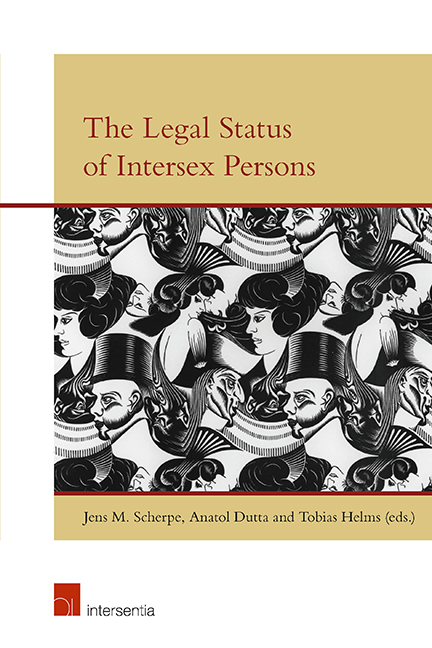Book contents
- Frontmatter
- Preface
- Contents
- List of Contributors
- The Legal Status of Intersex Persons: An Introduction
- Malta Declaration
- Darlington Statement
- Vienna Statement
- PART I MEDICINE AND PSYCHOLOGY
- Biology of Fetal Sex Development
- Intersex in the Brain: What Neuroscience can Tell the Law about Gender Identity
- Gender Identity and Intersex Conditions
- Evidence-Based Reviews of Medical Interventions Relative to the Gender Status of Children with Intersex Conditions and Differences of Sex Development
- PART II THEOLOGY AND LEGAL HISTORY
- PART III TRANSGENDER, TRANSSEXUALITY AND INTERSEX
- PART IV NATIONAL LEGAL DEVELOPMENTS
- PART V PRIVATE INTERNATIONAL LAW ASPECTS OF INTERSEX
- PART VI INTERSEX AND HUMAN RIGHTS
Biology of Fetal Sex Development
from PART I - MEDICINE AND PSYCHOLOGY
Published online by Cambridge University Press: 31 January 2019
- Frontmatter
- Preface
- Contents
- List of Contributors
- The Legal Status of Intersex Persons: An Introduction
- Malta Declaration
- Darlington Statement
- Vienna Statement
- PART I MEDICINE AND PSYCHOLOGY
- Biology of Fetal Sex Development
- Intersex in the Brain: What Neuroscience can Tell the Law about Gender Identity
- Gender Identity and Intersex Conditions
- Evidence-Based Reviews of Medical Interventions Relative to the Gender Status of Children with Intersex Conditions and Differences of Sex Development
- PART II THEOLOGY AND LEGAL HISTORY
- PART III TRANSGENDER, TRANSSEXUALITY AND INTERSEX
- PART IV NATIONAL LEGAL DEVELOPMENTS
- PART V PRIVATE INTERNATIONAL LAW ASPECTS OF INTERSEX
- PART VI INTERSEX AND HUMAN RIGHTS
Summary
INTRODUCTION
Mammalian sex development is a binary process established before birth so that the expectation at birth is that the sex of the baby is instantly recognisable as being female or male. When that is not the case, the term intersex has historically been used to describe an infant in whom the external genitalia are ambiguous in appearance and could be consistent with either a male or a female. Such a degree of ambiguity in humans is estimated to occur in in 4,500 to 5,500 births. If less severe forms of atypical genital development are also included, the problem affects as many as 1 in 300 births.
In order to understand the origins of intersex development, this chapter reviews how the outcome of the biological process of sex development is binary in the human fetus yet the embryological structures are present for that outcome to be bipotential. For that to happen, the bipotential structures must develop in response to biological drivers. These are genes and hormones which are produced during a critical period of fetal life and expressed in optimal concentrations.
THE EMBRYOLOGY
The development of the reproductive tract is sub-divided into formation of the internal and external genitalia. In both categories, the structures are bipotential with the capacity to form either male or female genitalia. Which it is, depends on genes and hormones.
THE GONADS
The structure which forms the gonads is termed the genital ridge, a region where the kidneys and adrenal glands also form. Until about five to six weeks of human gestation, the tissue forming the gonad is indeterminate on histological examination as being neither a testis or an ovary. The gonad is bipotential at this stage. A key gene which is present only on the Y (male) chromosome becomes expressed in the gonad if the egg at conception has been fertilised by a male bearing sperm (see Figure 1 and later in the text). Thereafter, the gonad becomes histologically distinguishable as a testis by cells that make testosterone (the male hormone) and other specialised cells that in later postnatal life make sperm. The bipotential gonad develops as an ovary when a female bearing sperm fertilises the egg and the Y chromosome-related key gene is absent.
- Type
- Chapter
- Information
- The Legal Status of Intersex Persons , pp. 25 - 44Publisher: IntersentiaPrint publication year: 2018
- 1
- Cited by

